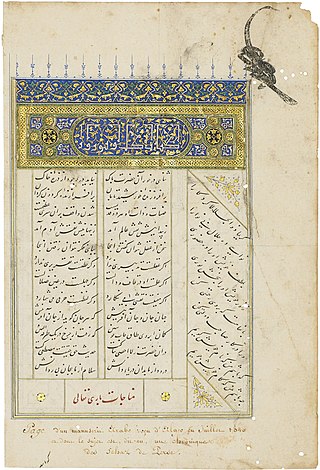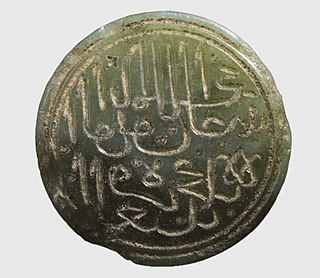Related Research Articles
Year 1374 (MCCCLXXIV) was a common year starting on Sunday of the Julian calendar.

The Qara Qoyunlu or Kara Koyunlu, also known as the Black Sheep Turkomans, were a culturally Persianate, Muslim Turkoman monarchy that ruled over the territory comprising present-day Azerbaijan, Georgia, Armenia, northwestern Iran, eastern Turkey, and northeastern Iraq from about 1374 to 1468.

The Chobanids or the Chupanids were descendants of a Mongol family of the Suldus clan that came to prominence in 14th century Persia. At first serving under the Ilkhans, they took de facto control of the territory after the fall of the Ilkhanate. The Chobanids ruled over Azerbaijan, Arrān, parts of Asia Minor, Mesopotamia, and west central Persia, while the Jalayirids took control in Baghdad.
Hasan Kuchak or Ḥasan-i Kūchik was a Chupanid prince during the 14th century. He is credited with setting up a nearly independent Chupanid state in Iran during the struggles taking place in the aftermath of the Ilkhanate. He effectively became kingmaker like his namesake Hasan Buzurg.
Dilshad Khatun, also Delshad, was a Chobanid princess. She was the wife of Ilkhan Abu Sa'id Bahadur Khan, and after him Hasan Buzurg, the first ruler of the Jalayirid Sultanate, and the mother of his son and successor Shaikh Awais.
Shaikh Hasan, also known as "Hasan Buzurg", Hassan the Jalair or Hassan-e Uljatâï was the first of several de facto independent Jalayirid rulers of Iraq and central Iran.

Shaykh Uways Jalayir was the Jalayirid ruler of Iraq (1356–1374) and Azerbaijan (1360–1374). He was the son of Hasan Buzurg and the Chobanid princess Dilshad Khatun.
Shaikh Hussain Jalayir was a Jalayirid ruler (1374–1382). He was the son of Shaikh Awais Jalayir. Following the execution of his brother Shaikh Hasan Jalayir, the amirs placed Shaikh Hussain Jalayir on the throne. Almost immediately he had to deal with an invasion by his brother-in-law Shah Mahmud of the Muzaffarids of Iran. Shah Mahmud, who was the son-in-law of Shaikh Awais Jalayir, advanced a claim on Tabriz and took the city. Illness, however, forced him to abandon the region. This was followed by an invasion by the leader of the Muzaffarids, Shah Shuja, but despite taking the city, he was also forced to retreat due to a rebellion in Qazvin. It was only in the summer of 1376 that Shaikh Hussain Jalayir took up residence in Tabriz. In the following spring, he undertook a successful campaign against the Black Sheep Turkmen under Bairam Khwaja, who had been raiding from the west.
Muhammad Khan was a claimant to the throne of the Ilkhanate.
Suleiman Khan was a Chobanid puppet for the throne of the Ilkhanate during the breakdown of central authority in Persia.

The Jalayirid Sultanate was a culturally Persianate, Mongol Jalayir dynasty which ruled over Iraq and western Persia after the breakup of the Mongol khanate of Persia in the 1330s. It lasted about fifty years, until disrupted by Timur's conquests and the revolts of the Qara Qoyunlu Turkoman. After Timur's death in 1405, there was a brief attempt to re-establish the sultanate in southern Iraq and Khuzistan. The Jalayirids were finally eliminated by the Qara Qoyunlu in 1432.

Togha Temür, also known as Taghaytimur, was a claimant to the throne of the Ilkhanate in the mid-14th century. Of the many individuals who attempted to become Ilkhan after the death of Abu Sa'id, Togha Temür was the only one who hailed from eastern Iran, and was the last major candidate who was of the house of Genghis Khan. His base of power was Gurgan and western Khurasan. His name "Togoy Tomor" means "Bowl/Pot Iron" in the Mongolian language.
Shaikh Bayazid Jalayir was the Jalayirid ruler of Soltaniyeh (1382–1384) in opposition to his brother Sultan Ahmed Jalayir. He was the son of Shaikh Awais Jalayir. In 1382 Bayazid and his brothers Ahmad and Shaikh Ali Jalayir plotted to overthrow their brother Shaikh Hussain Jalayir. Ahmad acted first, advancing from Ardabil to Tabriz and ordered Hussain's execution. Bayazid, who was in Tabriz, barely managed to escape. One of Hussain's amirs, 'Adil Aqa, opposed Ahmad and had Bayazid proclaimed as sultan in Soltaniyeh. In order to secure his position, Ahmad requested the assistance of the Black Sheep Turkmen; they killed Shaikh 'Ali in battle. Ahmad and Bayazid then attempted to form an agreement with each other; Bayazid was to receive the Jalayirid lands in Iraq-i 'Ajam and Ahmad would receive Azerbaijan, while Iraq-i 'Arab would be split between them. The agreement with the brothers failed to last, however, and Ahmad occupied Baghdad. In 1383 he gained entry into Soltaniyeh. At this point, Shah Shuja of the Muzaffarids of Iran intervened, and a new peace was brokered. Bayazid was confirmed in his possession of 'Iraq-i 'Ajam; 'Adil Aqa then left with Shah Shuja for Shiraz. 'Adil Aqa's departure left Bayazid without his principal ally, however, and in the spring of 1384 he gave up Soltaniyeh to Ahmad.
Sultan Ahmad was the ruler of the Jalayirid Sultanate, he was son to the most accomplished ruler of the sultanate, Shaykh Uways Jalayir. Early in his reign, he was involved in conflicts with his brothers. He would later suffer from several defeats with Timur and eventually imprisoned by the Mamluks. After being set free, he attacked his old enemy, the Qara Qoyunlu but was later captured and executed 1410.

Abu NasrQara Yusuf ibn MohammadBarani was the ruler of the Qara Qoyunlu dynasty from c.1388 to 1420, although his reign was interrupted by Tamerlane's invasion (1400–1405). He was the son of Qara Mahammad Töremish, a brother-in-law to Ahmad Jalayir.

Shah Shoja, was the ruler of the Mozaffarids from 1358 to 1384. He was the son and successor of Mubariz al-Din Muhammad. During the lengthy reign of Shah Shoja, his kingdom reached its zenith of power, stretching from Balochistan to Arran.
Hushang was the 32nd ruler of Shirvan and last member of the Kasranid branch of House of Shirvanshah.
Ispend, Aspand or Isfahan was the son of Qara Yusuf and ruled over Baghdad and its environs for twelve years.
Tandu Khatun or Tindu Khatun was a Jalayirid princess and regent of the Jalairid Sultanate in Iraq in 1411–1419.

Qara MahammadTöremish was a bey of Qara Qoyunlu and father of Qara Yusuf.
References
- Peter Jackson (1986). The Cambridge History of Iran, Volume Six: The Timurid and Safavid Periods. ISBN 0-521-20094-6
- Edward G. Browne (1926). A Literary History of Persia: The Tartar Dominion. ISBN 0-936347-66-X
- ↑ Wing, Patrick (2016). Jalayirids. Edinburgh: Edinburgh Univ Pr. p. 126. ISBN 978-1-4744-0226-2. OCLC 948403225.